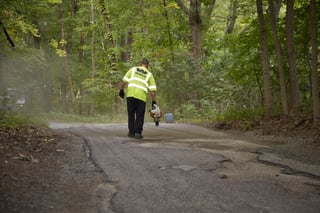
Wouldn’t it be great if big projects took care of themselves? Getting new asphalt pavement installed or repaired can feel like a lot, but when you break it up into five easy steps it suddenly becomes a lot more manageable.
If you’ve never had this kind of work done before it can be hard to figure out where to start. Our Asphalt Project Planning Guide will walk you through the process and even help you out with some of the initial research.
Download our free guide now to get more in-depth information on each step!
Step 1: Evaluating The Current State Of Your Asphalt
Before you do anything else, go outside and take a good look at the current state of your asphalt pavement. Look for problem areas and take note of areas of concern for your driveway, roadway or parking lot.
Look for any visible damage, such as:
- Cracks larger than ¼ inch
- Potholes
- Heaving
- Oil stains
- Faded paint
For more information on what your estimator will be looking for and other elements that will impact the size and scope of your project get our FREE planning kit.
Step 2: Researching The Repair Options Available for Asphalt
As you evaluate the best way to proceed with your asphalt project, understanding the asphalt repair process and what will be involved is important. As such, it is important to familiarize yourself with different methods of asphalt repair because there might be more than one answer to your asphalt problem.
Crack Filling - One of the biggest mistake people make when it comes to cracks in their pavement, is waiting too long to get them filled. With time, cracks will only grow bigger. What was once a small crack can quickly become alligator cracking or even a pothole, compromising the integrity of your entire pavement surface.
Sealcoating - Sealcoating will protect asphalt from fuel, oil, water, weather and traffic wear. This option will leave your pavement looking sleek and dark, and is the perfect solution if you are looking for a simple way to improve the appearance of your asphalt road or driveway.
Milling - Milling is the process of removing the top layer of asphalt without disturbing the underlying subbase. This is an excellent option if your subbase is perfectly functional and only the top layer of your asphalt needs repair work.
Patching - Patching is the process of filling in potholes. You can learn more here.
Overlay - An asphalt overlay can be thought of as a large patching job over a stretch of asphalt. Overlay is typically used when existing asphalt is showing some signs of cracking and potholes, but not quite enough damage to warrant a full replacement.
New Installation - A fresh start for your pavement.
You can get more details about these options in our FREE planning guide.

Step 3: Looking Into The Different Types Of Asphalt
There are a lot of options available to you. Here are the most popular.
Porous Asphalt - The term “porous” refers to the fact that there are tiny holes in the asphalt material which provide an environmentally friendly way to manage stormwater. The water travels into the ground beneath where it undergoes natural water cleansing processes. Porous asphalt is an environmentally friendly paving solution and as an EPA best practice paving, using it for your next project can even offer your business tax benefits.
Cold Mix Asphalt - Cold mix asphalt is good for filling potholes in winter because it stays soft in cold temperatures and repels water. It will drive water out of the pothole and adhere to the surface underneath. The manufacturing process is also simpler than the hot mix process.
Hot Mix Asphalt - Hot mix asphalt (HMA) is the designation given to asphalt mixtures that are heated and poured at temperatures between 300 and 350 degrees Fahrenheit. It is the most commonly used asphalt.
Custom Mixes - Wolf Paving owns its own asphalt production plant. We have more than 20 custom mixes of asphalt blends, with plenty of specialty mixes to ensure we have the right kind of asphalt for every application.
Step 4: Budgeting For Your Asphalt Project
If you’re a business owner you should leave room in your budget for a pavement restoration project every 10 years. You may not need the work done every 10 years, but it’s best to layout your budget as if you would, just in case.
The easiest way to avoid costly projects is to do smaller maintenance projects that will keep your asphalt from needing big repairs in the first place. Quick, inexpensive maintenance includes:
- Regular sealcoating
- Seasonal street sweeping
- Crack sealing when cracks first appear
Step 5: Contact The Experts For A Quote On Your Project.
Taking the time to read up on paving best practices and familiarizing yourself with industry terminology and processes can save you time in the long run. Being informed can give you the confidence to know the important questions to ask a contractor.
You can get a free consultation and estimate with one of our paving experts via phone or email. We respect your privacy and any information you provide will be kept confidential.
Our focus is on keeping you informed and helping you make the best choices for your unique project. Contact our Oconomowoc or Sun Prairie offices today to get your free quote.
Oconomowoc: (262) 965-2121
Sun Prairie: (608) 249-7931





